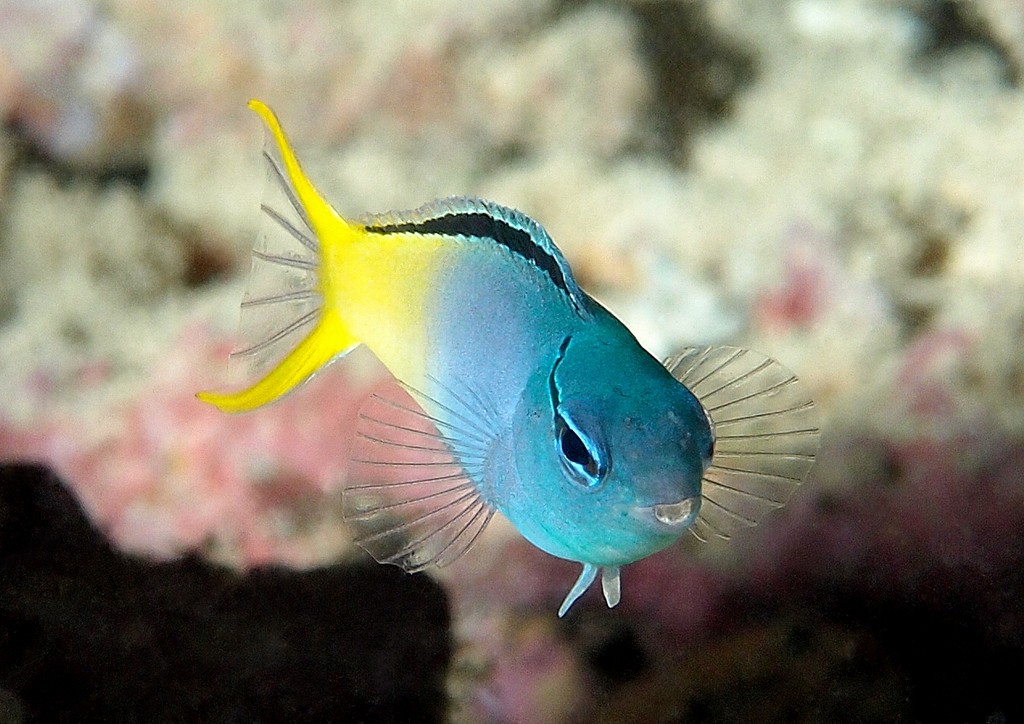MEIACANTHUS ATRODORSALIS - (GUNTHER, 1877)
Actinopterygii (Gigaclass) > Actinopteri (Class) > Teleostei (Subclass) > Blenniiformes (Order) > Blennioidei (Suborder) > Blenniidae (Family) > Blenniinae (Subfamily) > Meiacanthus (Genus)
Blennie à bande noire, Eye-lash harptail-blenny, Eyelash fangblenny, Eyelash harp-tail, Forktail blenny, Lyretail blenny, Poison-fang blenny, Yellowtail fangblenny, Yellowtail poison-fang blenny, ôgon-nijiginpo, オウゴンニジギンポ, 稀棘鳚, 金鰭稀棘鳚,
Synonymes
Meiacanthus atrodorsalis atrodorsalis (Günther, 1877)
Petroscirtes atrodorsalis (Günther, 1877)
Petroscirtes herlihyi (Fowler, 1946)
------------------------
Description
Dorsal spines (total): 4; Dorsal soft rays (total): 25-28; Anal spines: 2; Anal soft rays: 15-18; Pectoral fin rays: 14; Segmented caudal rays: 11, none branched. An enormous curved, venomous fang on each side of the lower jaw grooved on anterior surface, with a venom gland at base. The fangs are used for defence. Origin of dorsal fin over posterior margin of preopercle, the fin low and unnotched; Caudal fin lunate, the lobes prolonged in large males. Max. length: 11.0 cm. Depth range: 1 - 30 m.
Color
Head and anterior half of body grey-blue, posterior half yellow; A diagonal black band through eye, continuing dorsoposteriorly onto nape; A black stripe in dorsal fin except posteriorly; Caudal fin yellow; A black spot in lower port of pectoral fin axil.
Etymology
Meiacanthus: from Greek, meion = less or lessen + from Greek, akantha = thorn. Referring to dorsal fin with only 4-8 spines, compared to 10-12 on the related Petroscirtes.
atrodorsalis: from Latin, atro = black + from Latin, dorsalis = of the back. Referring to the dark submarginal stripe usually present in the dorsal fin.
Original description: Petroscirtes atrodorsalis Günther, 1877 - Type locality: Samoa.
Distribution
Eastern Indian Ocean, western Pacific: Indonesia, east to Caroline Islands and Samoa, north Ryukyu Islands (Japan), south to northern Australia and New Caledonia.
Biology
Adults are found solitary or in pairs in lagoon and seaward reefs. A common species, often seen along slopes and drop-offs, adults sometimes in small groups. Feed on zooplankton and also on small benthic invertebrates. Inoffensive, but immune from predation. Oviparous. Eggs are demersal and adhesive, and are attached to the substrate via a filamentous, adhesive pad or pedestal. Larvae are planktonic, often found in shallow, coastal waters. Venomous for humans.
Similar species
Ecsenius bicolor (Day, 1888) - Reported from New Caledonia - Link to the species (here).
Meiacanthus oualanensis (Günther, 1880) - Reported from Western Pacific: Fiji.
Meiacanthus tongaensis (Smith-Vaniz, 1987) - Reported from Central Pacific: Tonga.
Meiacanthus phaeus (Smith-Vaniz, 1976) - Reported from Western Pacific: Coral Sea, New Caledonia and Chesterfield Island.
Plagiotremus laudandus (Whitley, 1961) - Reported from New Caledonia - Link to the species (here).
Last update: 7, April 2024
Blennie à bande noire, Eye-lash harptail-blenny, Eyelash fangblenny, Eyelash harp-tail, Forktail blenny, Lyretail blenny, Poison-fang blenny, Yellowtail fangblenny, Yellowtail poison-fang blenny, ôgon-nijiginpo, オウゴンニジギンポ, 稀棘鳚, 金鰭稀棘鳚,
Synonymes
Meiacanthus atrodorsalis atrodorsalis (Günther, 1877)
Petroscirtes atrodorsalis (Günther, 1877)
Petroscirtes herlihyi (Fowler, 1946)
------------------------
Description
Dorsal spines (total): 4; Dorsal soft rays (total): 25-28; Anal spines: 2; Anal soft rays: 15-18; Pectoral fin rays: 14; Segmented caudal rays: 11, none branched. An enormous curved, venomous fang on each side of the lower jaw grooved on anterior surface, with a venom gland at base. The fangs are used for defence. Origin of dorsal fin over posterior margin of preopercle, the fin low and unnotched; Caudal fin lunate, the lobes prolonged in large males. Max. length: 11.0 cm. Depth range: 1 - 30 m.
Color
Head and anterior half of body grey-blue, posterior half yellow; A diagonal black band through eye, continuing dorsoposteriorly onto nape; A black stripe in dorsal fin except posteriorly; Caudal fin yellow; A black spot in lower port of pectoral fin axil.
Etymology
Meiacanthus: from Greek, meion = less or lessen + from Greek, akantha = thorn. Referring to dorsal fin with only 4-8 spines, compared to 10-12 on the related Petroscirtes.
atrodorsalis: from Latin, atro = black + from Latin, dorsalis = of the back. Referring to the dark submarginal stripe usually present in the dorsal fin.
Original description: Petroscirtes atrodorsalis Günther, 1877 - Type locality: Samoa.
Distribution
Eastern Indian Ocean, western Pacific: Indonesia, east to Caroline Islands and Samoa, north Ryukyu Islands (Japan), south to northern Australia and New Caledonia.
Biology
Adults are found solitary or in pairs in lagoon and seaward reefs. A common species, often seen along slopes and drop-offs, adults sometimes in small groups. Feed on zooplankton and also on small benthic invertebrates. Inoffensive, but immune from predation. Oviparous. Eggs are demersal and adhesive, and are attached to the substrate via a filamentous, adhesive pad or pedestal. Larvae are planktonic, often found in shallow, coastal waters. Venomous for humans.
Similar species
Ecsenius bicolor (Day, 1888) - Reported from New Caledonia - Link to the species (here).
Meiacanthus oualanensis (Günther, 1880) - Reported from Western Pacific: Fiji.
Meiacanthus tongaensis (Smith-Vaniz, 1987) - Reported from Central Pacific: Tonga.
Meiacanthus phaeus (Smith-Vaniz, 1976) - Reported from Western Pacific: Coral Sea, New Caledonia and Chesterfield Island.
Plagiotremus laudandus (Whitley, 1961) - Reported from New Caledonia - Link to the species (here).
Last update: 7, April 2024
